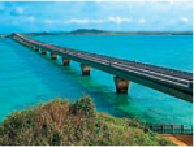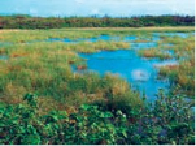Travel Reference
In-Depth Information
The Ikema Great Bridge connects the northern-most tip of Miyako with tiny Ikema Island.
Kurima is mostly flat and almost entirely planted with sugar cane. If you're looking for
privacy, you'll find it on any one of several attractive, secluded, small beaches on the west-
ern side of the island. One of the best is Nagamahama Beach (
長間浜
; Nagama hama). You'll
probably have it all to yourself.
Kurima's eastern side, that is the side facing Miyako, has some modest cliffs and on the is-
land's highest point, 197 feet (60 meters), you'll find the quite elaborate three-story Ryugu-jo
Observatory (
竜宮城展望台
; Ryūgū-jō tenbō-dai). It was designed to resemble the supposed
undersea palace of Ryūjin (
龍神
), the dragon god of the sea in Japanese mythology. It has a
wonderful view of all Kurima, plus the bridge back to Miyako, plus the white sand Yonaha-
Maehama Beach and the Tokyu Resort Hotel.
Unusually, the Ikema Wildlife Sanctuary encompasses a large freshwater pond and marshlands.
IKEMAJIMA
(
池間島
; Ikéma-jima). The northernmost tip of Miyako used to end at Cape
Nishi-Henna (
西平安名崎
; Nishi Henna-zaki). That changed in 1992 when the Ikema Great
Bridge (
池間大橋
; Ikéma-Ōhashi) was completed. It artificially extended Miyako's reach all
the way to Ikema and replaced the local ferry service. At 4,675 feet (1,425 meters) long, the
Ikema-Ōhashi was the longest bridge in Japan at the time of its opening, but it wasn't long be-
fore that record was broken and longer bridges were completed, including the Kurima Bridge
at the other end of Miyako.


